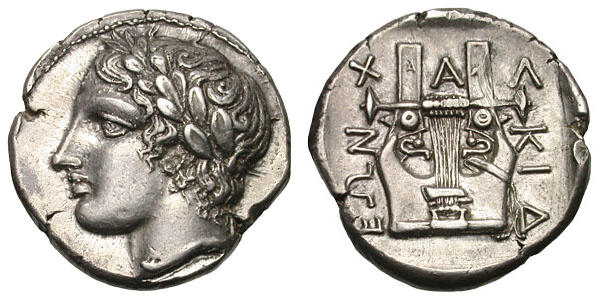AC 156a - Olynthus (Chalcidian League), silver, staters (420-358 BCE)
From SILVER
420 BCE - 358 BCE Silver 1,655 kg
Description
| ObverseInscription or printing placed on the obverse.: | Laureate head of Apollo left. |
| ReverseInscription or printing placed on the reverse.: | Χ-Α-Λ/ΚΙΔ/ΕΩΝ (Greek).Cithara with seven strings, and a rag wrapped around the lower end of the strings, at the top of the struts, the signature Α-Μ, a strap attached to the bottom of the right strut. |
Mint and issuing power
| MintIdentifies the place of manufacture or issue of a numismatic object.: | Olynthus | Ancient regionAncient region.: | Macedon | Modern countryModern country: Greece | AuthorityIdentifies the issuing power. The authority can be "pretended" when the name or the portrait of X is on the coin but he/she was not the issuing power. It can also be "uncertain" when there is no mention of X on the coin but he/she was the issuing power according to the historical sources: | Chalcidian League (c. 430-348 BC) |
Chronology
| FromIdentifies the initial date in a range assigned in a numismatic context. | 420 BCE | toIdentifies the final date in a range assigned in a numismatic context.. | 358 BCE | PeriodTime period of the numismatic object.: Classical 480-323 BC |
Physical description
| MetalThe physical material (usually metal) from which an object is made.: | Silver |
Median weightMedian of the weights of numismatic objects (in grams). in grams | 8.60 | DenominationTerm indicating the value of a numismatic object. Examples: tetradrachm, chalkous, denarius.: | stater |
StandardStandard.: |
Image

AC156a Olynthus.jpeg [1]
References
| Die study referencePublication of the study: | Robinson - Clement 19381Robinson - Clement 1938 | ||
| Coin series referenceReference to coin series study: | HGC 3.12HGC 3.1, n° 500, RQEMAC3RQEMAC, n° 156a | ||
Obverse dies distribution
no distribution is available
Reverse dies distribution
no distribution is available
Quantification
| Number of obversesNumber of obverse dies. ᵖ (o) | 4 | Number of singletons (o1)The number of singleton coins. ᵖ | |
| Number of reverse diesNumber of reverse dies. (r) | 5 | Number of coinsNumber of coins. (n) | 6 |
| Coins per obverse dieNumber of coins per obverse die. (n/o) | 1.5 | Coins per reverse dieNumber of coins per reverse die. (n/r) | 1.2 |
| Reverse per obverse ratioRatio of obverse dies divided by reverse dies. (r/o) | 1.25 | Percentage of singletons (o1)number of coins (n) divided by the number of singletons (o1) ᵖ | % |
| Original number of dies (O) (Carter 1983 formula)The estimation of the number of coins according to Carter 1983 ᵖ | 9.62 | Coins struck if 20,000 as average productivity per dieCoins made if the average productivity for obverses (according to Carter) is 20,000. ᵖ | 192,400 |
| Original number of dies (O) (Esty 2011 formula)The estimation of the number of coins according to the singleton formula in Esty 2011 ᵖ (O) | 12 | Survival rate if 20,000 as average productivity per dieSurvival rate if average productivity is 20,000. ᵖ | 0.00003 |
| Coverage (o = % of O) (Esty 1984 formula)Esty 1984 - coverage (% of O) ᵖ (o = % of O) | % | Die productivity if survival rate 1/2,000Average productivity if survival rate is 1/2,000. ᵖ | 1,247.4 |
| Weight of silver (in kg) if 20,000 coins per die (O = Carter formula)Carter 1983 * Median weight * 20000 (*10 if gold or electrum) ᵖ | 1,655 kg <br /> 1,655 kg | Die productivity if survival rate 1/5,000Average productivity if survival rate is 1/5,000. ᵖ | 3,118.5 |
Remarks
References
- ^ Robinson, David M. - Clement, Paul Augustus (1938), Excavations at Olynthus. Part IX : The Chalcidic Mint and the Excavations Coins Found in 1928-1934, Baltimore.
- ^ Hoover, Oliver D. (2016), Handbook of coins of Macedon and its neighbors. 3. Part I: Macedon, Illyria, and Epeiros, sixth to first centuries BC, Lancaster, 437 p.
- ^ Callataÿ, François de (2003), Recueil quantitatif des émissions monétaires archaïques et classiques, Numismatique Romaine, Wetteren, VII + 267 p.